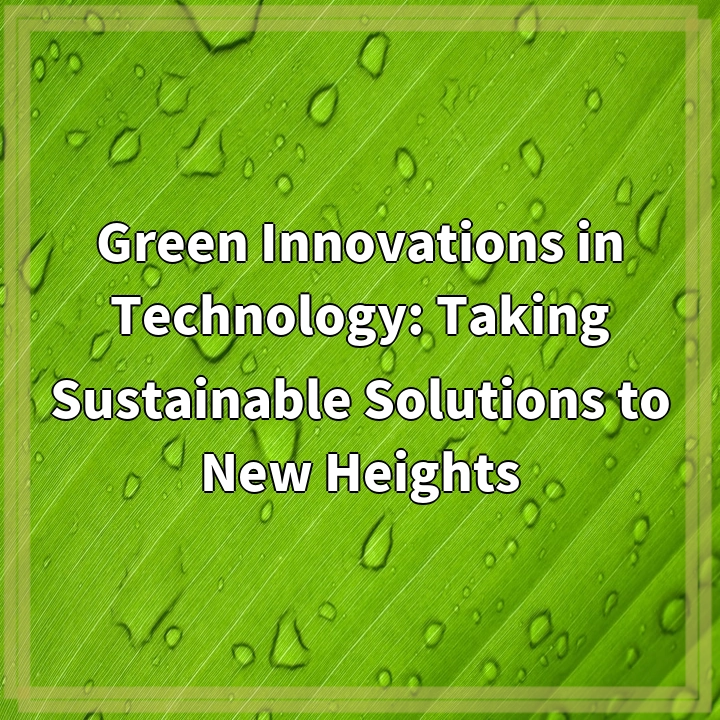
What it is:
Green Innovations in Technology refers to the development and implementation of sustainable solutions within the technological sector. It involves the creation and use of innovative technologies that not only meet the needs of society but also minimize negative environmental impacts. These solutions aim to address pressing environmental challenges, such as climate change, pollution, resource depletion, and habitat destruction. By integrating sustainability into technology, we can strive towards a greener and more sustainable future.
Real-world problems:
As we navigate the challenges of the 21st century, numerous real-world problems necessitate the adoption of green innovations in technology. These problems include but are not limited to:
1. Climate change:
Climate change is one of the most critical environmental issues we face. Green innovations in technology play a crucial role in mitigating greenhouse gas emissions and reducing our carbon footprint. Technologies such as renewable energy systems, energy-efficient buildings, electric vehicles, and carbon capture and storage are essential for transitioning to a low-carbon economy.
2. Pollution:
Pollution is another significant problem that requires sustainable technological solutions. Green innovations can help curb air, water, and soil pollution by developing cleaner and more efficient industrial processes and waste management systems. Additionally, advancements in recycling and waste-to-energy technologies can contribute to reducing the amount of waste sent to landfills.
3. Resource depletion:
The depletion of natural resources, such as fossil fuels and minerals, poses significant challenges for our society. Green innovations in technology focus on finding alternative and renewable resources that are less harmful to the environment. This includes exploring solar, wind, and hydroelectric power as well as developing sustainable agricultural practices and circular economy models.
4. Habitat destruction:
The destruction of ecosystems and loss of biodiversity is a growing concern. Green innovations in technology aim to minimize habitat destruction and protect biodiversity by promoting sustainable land use practices, preserving natural habitats, and developing technologies that minimize the impact on wildlife and ecosystems.
In conclusion,
Green innovations in technology are essential for addressing the pressing environmental challenges we face. By developing and implementing sustainable solutions, we can reduce our ecological footprint and pave the way for a more sustainable future.

Solutions:
Green innovations in technology offer a range of solutions to the real-world problems discussed above. These solutions include:
1. Embracing renewable energy:
One of the key solutions is the widespread adoption of renewable energy sources such as solar, wind, and hydroelectric power. Investing in and developing technologies that harness these clean and abundant sources of energy can help reduce reliance on fossil fuels and significantly lower greenhouse gas emissions.
2. Promoting energy efficiency:
Improving energy efficiency in various sectors is another critical solution. This involves the development of energy-efficient appliances, buildings, and transportation systems. Implementing smart grid technologies and optimizing industrial processes can also contribute to significant energy savings and a more sustainable energy landscape.
3. Implementing circular economy models:
Adopting circular economy models is an effective approach to minimize resource depletion and waste generation. By designing products and systems that prioritize recycling, reuse, and remanufacturing, we can create a more sustainable and closed-loop economy that minimizes waste and maximizes resource efficiency.
4. Advancing sustainable agriculture:
Promoting sustainable agricultural practices is crucial for food security and environmental preservation. Technologies such as precision agriculture, vertical farming, and agroforestry can minimize the use of harmful pesticides, reduce water consumption, and protect soil health, thereby ensuring a more sustainable and resilient future for our food systems.
5. Encouraging innovation and collaboration:
Nurturing a culture of innovation and collaboration is essential for driving green advancements in technology. This involves fostering partnerships between academia, industry, and governments to promote research and development of sustainable technologies. Emphasizing open-source platforms and sharing knowledge and best practices can accelerate progress and create a collective impact.
In conclusion,
Green innovations in technology provide a diverse range of solutions to tackle the real-world problems we face. By embracing renewable energy, promoting energy efficiency, implementing circular economy models, advancing sustainable agriculture, and fostering innovation and collaboration, we can pave the way for a greener and more sustainable future for generations to come.















